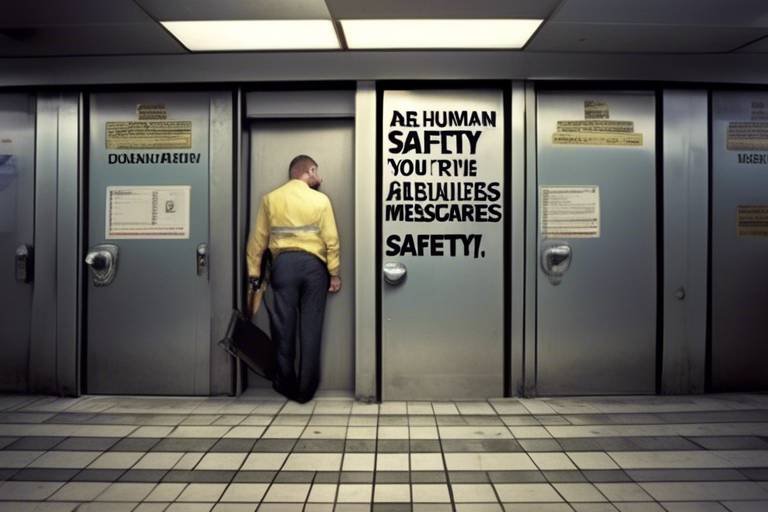Safety Standards - What Impact Can Human Behavior Have On It?
When we think about safety standards, we often picture rules, regulations, and protocols designed to keep us safe in various environments, especially in the workplace. But have you ever stopped to consider the role that human behavior plays in this equation? It’s like the invisible thread weaving through the fabric of safety; without it, everything can unravel. The intricate relationship between our actions, decisions, and attitudes significantly influences how effectively these safety standards are implemented and followed. In this article, we will explore how our behavior impacts safety compliance, the common risks we face, and the pivotal role of leadership in fostering a culture that prioritizes safety.
Understanding how human behavior affects safety compliance is crucial for any organization aiming to minimize risks. Think about it: safety protocols are only as effective as the people who follow them. Psychological factors, such as motivation, perception of risk, and even social influences, can lead to either adherence or deviation from established safety standards. For instance, an employee may know the safety rules but might take shortcuts due to pressure to meet deadlines or a belief that “it won’t happen to me.” This mindset can lead to dangerous situations, making it essential for organizations to address these psychological barriers head-on.
Identifying common behavioral risks is essential for enhancing safety. Just as a chain is only as strong as its weakest link, workplace safety hinges on the collective behavior of all employees. Some typical behaviors that compromise safety include:
- Ignoring safety protocols: Skipping steps in safety procedures can lead to catastrophic results.
- Complacency: Employees may become too comfortable in their routines, leading to lapses in attention.
- Distraction: Multitasking or engaging in conversations while performing safety-sensitive tasks can divert focus.
Addressing these behaviors proactively is not just a good practice; it's a necessity for maintaining a safe work environment.
Negligence in following safety protocols can lead to severe consequences. Imagine a construction site where workers disregard safety gear; the potential for accidents skyrockets. Careless behavior not only endangers individuals but can also have far-reaching implications for the entire organization. From financial losses due to accidents and injuries to damage to reputation and employee morale, the fallout from negligence can be devastating. It’s like playing with fire—one small spark can lead to a raging inferno.
Examining real-life case studies illustrates the impact of negligence on safety standards. For example, consider the infamous Deepwater Horizon oil spill. In this case, a series of human errors and failures to adhere to safety protocols resulted in one of the largest environmental disasters in history. Such examples provide a sobering reminder of the potential consequences of ignoring safety measures.
Implementing preventive measures can significantly reduce negligence. Organizations can foster a culture of safety compliance by:
- Conducting regular safety training: Continuous education helps keep safety protocols fresh in employees' minds.
- Encouraging open communication: Employees should feel comfortable reporting unsafe conditions without fear of reprisal.
- Recognizing safe behaviors: Positive reinforcement can motivate employees to adhere to safety standards.
By adopting these strategies, organizations can create an environment where safety is a shared responsibility.
Effective training and awareness programs are vital for promoting safe behaviors. Think of these programs as the backbone of a safety culture. They equip employees with the knowledge and skills necessary to recognize hazards and respond appropriately. Continuous education not only enhances safety standards but also fosters a sense of ownership among employees. When individuals feel empowered and informed, they are more likely to take safety seriously, making it a natural part of their daily routines.
Leadership plays a pivotal role in shaping safety culture. Leaders set the tone for the organization and can significantly influence employee behavior towards prioritizing safety in the workplace. When leaders prioritize safety, it sends a powerful message that safety is a core value rather than just a checkbox on a compliance list. Their commitment can inspire employees to adopt similar attitudes, creating a ripple effect throughout the organization.
Cultivating a safety-first mindset among employees is essential. Leaders can instill this culture by leading by example, openly discussing safety issues, and involving employees in safety planning. When employees see their leaders actively engaged in safety practices, they are more likely to follow suit. It’s about creating a community where safety is everyone’s responsibility, not just a set of rules to follow.
Fostering accountability and responsibility among employees enhances safety. Clear expectations and consequences can motivate safer behavior in the workplace. When employees understand that their actions have direct implications for their safety and that of their colleagues, they are more likely to take safety protocols seriously. This accountability creates a culture where safety is prioritized, and everyone works together to maintain a safe environment.
Q: How can organizations improve safety compliance?
A: Organizations can improve safety compliance by providing regular training, encouraging open communication, and fostering a culture of accountability.
Q: What role does leadership play in workplace safety?
A: Leadership sets the tone for safety culture. When leaders prioritize safety, it influences employees to adopt similar attitudes and behaviors.
Q: What are common behavioral risks in the workplace?
A: Common behavioral risks include ignoring safety protocols, complacency, and distraction while performing safety-sensitive tasks.
Q: How can negligence impact workplace safety?
A: Negligence can lead to severe consequences, including accidents, financial losses, and damage to organizational reputation.

The Role of Human Behavior in Safety Compliance
Understanding how human behavior affects safety compliance is crucial for any organization aiming to maintain a safe working environment. At the heart of safety compliance lies the intricate web of psychological factors that drive individuals to either adhere to or deviate from established safety standards. Imagine a workplace where every employee is not just aware of the safety protocols but actively engaged in following them. This ideal scenario hinges on the collective behavior of the workforce.
One of the primary reasons for non-compliance is the tendency of individuals to underestimate risks. Often, workers might think, "It won't happen to me," leading to a false sense of security. This mindset can be detrimental, as it fosters a culture of complacency where safety measures are seen as mere suggestions rather than essential practices. The reality is that human behavior is influenced by various factors, including personal attitudes, peer pressure, and the organizational culture itself.
Moreover, the psychological factors influencing safety compliance can be categorized into several areas:
- Perception of Risk: How individuals perceive the likelihood of accidents can significantly impact their compliance with safety protocols.
- Motivation: Employees who are motivated—either intrinsically or extrinsically—are more likely to follow safety guidelines.
- Awareness and Education: Continuous training helps keep safety at the forefront of employees' minds, enhancing compliance.
Additionally, organizational culture plays a pivotal role in shaping behaviors. A culture that prioritizes safety will encourage employees to take ownership of their actions. When leaders demonstrate a commitment to safety, it sets a precedent that influences the behavior of the entire team. This is where the concept of a “safety-first mindset” comes into play, where safety becomes a shared value rather than an isolated responsibility.
Furthermore, the consequences of non-compliance extend beyond the immediate workplace. They can lead to injuries, financial losses, and even legal repercussions. Organizations must recognize that human behavior is not static; it can be influenced and improved through targeted interventions. With the right strategies in place, companies can foster an environment where safety compliance is not just expected but embraced.
In conclusion, the role of human behavior in safety compliance cannot be overstated. By understanding the psychological factors at play and fostering a culture that prioritizes safety, organizations can significantly enhance their safety standards. It's not just about having rules in place; it's about creating a workplace where every individual feels responsible for upholding those standards.

Common Behavioral Risks in the Workplace
When we think about workplace safety, it's easy to focus solely on the physical environment—like machinery, equipment, and safety gear. However, human behavior plays an equally critical role in maintaining safety standards. In fact, many workplace accidents can be traced back to behavioral risks that stem from poor decision-making, lack of awareness, or even complacency. Understanding these risks is essential for any organization aiming to foster a culture of safety.
One of the most prevalent behavioral risks is complacency. Over time, employees may become so familiar with their tasks that they start to overlook safety protocols. This is especially true in environments where routine tasks are performed daily. For instance, a factory worker who has been operating a machine for years might skip safety checks, believing they know everything there is to know. This false sense of security can lead to dangerous situations.
Another significant risk is distraction. In today’s fast-paced work environment, distractions are everywhere—be it smartphones buzzing with notifications, colleagues chatting nearby, or even multitasking between different duties. When employees are distracted, they are less likely to pay attention to safety measures, increasing the likelihood of accidents. For example, a construction worker who is busy texting might not notice a colleague using heavy machinery nearby, posing a severe risk to both parties.
Negligence is also a major behavioral risk. This can manifest in various ways, from ignoring safety signs to failing to wear appropriate personal protective equipment (PPE). Negligent behavior often stems from a lack of training or understanding of the importance of safety protocols. When employees don’t see the immediate consequences of their actions, they may not take safety seriously, leading to a culture where safety standards are routinely ignored.
Furthermore, poor communication can exacerbate these risks. If safety protocols are not clearly communicated or if there is a lack of feedback regarding unsafe behaviors, employees may not fully understand their responsibilities. This can create an environment where unsafe practices go unchallenged, putting everyone at risk. For instance, if a team leader fails to address unsafe behavior during a safety briefing, employees may assume such behavior is acceptable.
Addressing these behavioral risks requires a proactive approach. Organizations must not only identify these risks but also implement strategies to mitigate them. Regular training sessions can help reinforce the importance of safety protocols, while open lines of communication can encourage employees to speak up about unsafe practices. By fostering an environment where safety is prioritized, organizations can significantly reduce the likelihood of accidents caused by human behavior.
In summary, understanding and addressing common behavioral risks in the workplace is crucial for enhancing overall safety. By recognizing the impact of complacency, distraction, negligence, and poor communication, organizations can take actionable steps to improve safety standards and create a safer work environment for everyone.
- What are common behavioral risks that affect workplace safety?
Common risks include complacency, distraction, negligence, and poor communication. - How can organizations mitigate these risks?
Through regular training, clear communication, and a culture that prioritizes safety. - Why is human behavior critical in workplace safety?
Human behavior directly influences adherence to safety protocols, making it essential for preventing accidents.

Negligence and Its Consequences
Negligence in the workplace is not just a minor oversight; it can have profound implications for both individuals and organizations. When employees fail to adhere to safety protocols, the consequences can be catastrophic. Imagine a construction site where a worker neglects to wear a hard hat. This seemingly small act of carelessness can lead to severe injuries or even fatalities. The ripple effects of such negligence extend beyond the individual, impacting coworkers, families, and the organization as a whole.
One of the most alarming aspects of negligence is its potential to create a culture of complacency. When employees observe their peers ignoring safety measures without facing repercussions, they may begin to think, "If they can get away with it, so can I." This mindset can lead to a domino effect, where one negligent act encourages another, ultimately resulting in a hazardous work environment.
Furthermore, the financial implications of negligence are staggering. Organizations may face hefty fines, increased insurance premiums, and potential lawsuits. According to a study by the National Safety Council, workplace injuries cost U.S. employers over $171 billion annually. This figure highlights the importance of addressing negligence proactively rather than reactively. Companies should not only focus on compliance but also on fostering an atmosphere where safety is prioritized and ingrained in the workplace culture.
To better understand the consequences of negligence, consider the following table that outlines some common outcomes:
| Type of Consequence | Description |
|---|---|
| Injuries | Physical harm to employees, ranging from minor injuries to life-threatening situations. |
| Legal Ramifications | Potential lawsuits and fines from regulatory bodies due to non-compliance with safety standards. |
| Financial Loss | Increased costs related to medical care, rehabilitation, and legal fees, alongside potential loss of business. |
| Reputation Damage | Negative public perception and loss of trust from clients and stakeholders, which can take years to rebuild. |
Addressing negligence is not merely a matter of following rules; it requires a cultural shift within organizations. Leaders must actively promote safety awareness and encourage employees to speak up about unsafe practices. By doing so, they create an environment where everyone feels responsible for maintaining safety standards. It's about instilling a sense of ownership in employees, making them realize that their actions have real consequences.
In conclusion, negligence in the workplace can lead to dire consequences, affecting not only the individuals involved but also the organization and its stakeholders. By recognizing the importance of safety compliance and taking proactive measures to mitigate risks, organizations can foster a culture of safety that protects everyone. After all, safety is a collective responsibility, and it starts with each individual making conscious choices to prioritize it every day.
- What is negligence in the workplace? Negligence refers to the failure to take proper care in doing something, which can lead to accidents or unsafe conditions in the workplace.
- How can organizations reduce negligence? Organizations can reduce negligence by implementing comprehensive training programs, establishing clear safety protocols, and fostering a culture of accountability.
- What are the legal implications of workplace negligence? Legal implications can include lawsuits, fines, and increased insurance costs, which can have a significant financial impact on an organization.
- Why is safety culture important? A strong safety culture encourages employees to prioritize safety, reducing the likelihood of accidents and fostering a healthier work environment.

Case Studies of Negligence
When we talk about negligence in the workplace, it’s not just a theoretical concept; it has real-world implications that can be dire. Let’s take a moment to examine some case studies that highlight the impact of negligence on safety standards. These examples serve as a stark reminder of how a single oversight can lead to catastrophic outcomes.
One prominent case occurred in a manufacturing plant where safety protocols were disregarded during routine maintenance. Workers were instructed to bypass safety guards on machinery to expedite the process. As a result, an employee suffered a severe injury when a machine unexpectedly activated. This incident not only resulted in physical harm but also led to a significant financial burden for the company due to medical expenses and legal fees. The aftermath revealed a culture where shortcuts were normalized, ultimately compromising worker safety.
Another striking example is from the construction industry, where a site manager neglected to enforce proper safety training for new hires. In this case, a worker fell from scaffolding due to inadequate safety harness use. The investigation revealed that the manager had failed to conduct safety briefings, leading to a lack of awareness about the dangers present on the site. This negligence not only endangered lives but also tarnished the company’s reputation, leading to lost contracts and increased scrutiny from regulatory bodies.
To better understand the implications of these cases, let’s summarize the key points in the table below:
| Case Study | Industry | Negligent Action | Consequences |
|---|---|---|---|
| Manufacturing Plant Incident | Manufacturing | Bypassing safety guards | Severe injury, financial burden, legal fees |
| Construction Site Fall | Construction | Failure to enforce safety training | Worker injury, damaged reputation, lost contracts |
These case studies are not just cautionary tales; they emphasize the need for a proactive approach to safety compliance. Organizations must recognize that negligence can stem from a variety of factors, including poor training, inadequate supervision, and a lack of accountability. By examining these real-life scenarios, we can glean valuable lessons on the importance of adhering to safety standards. Ignoring these lessons can lead to tragic outcomes that could have been easily avoided.
In conclusion, the impact of negligence on safety standards is profound and multifaceted. It is crucial for organizations to foster a culture of safety where every employee feels responsible for their own safety as well as that of their colleagues. By learning from past mistakes and implementing rigorous safety protocols, we can help prevent future incidents and create a safer workplace for everyone.
- What are the main causes of negligence in the workplace? Negligence can arise from a lack of training, poor communication, inadequate supervision, and a culture that prioritizes speed over safety.
- How can organizations prevent negligence? Organizations can prevent negligence by implementing comprehensive training programs, conducting regular safety audits, and fostering open communication about safety concerns.
- What are the legal implications of workplace negligence? Legal implications can include fines, lawsuits, and increased scrutiny from regulatory agencies, which can severely affect a company's reputation and financial stability.

Preventive Measures Against Negligence
Negligence in the workplace can have catastrophic effects, not only on the safety of employees but also on the overall success of an organization. To combat this issue effectively, it is essential to implement a series of preventive measures that address the root causes of negligent behavior. First and foremost, fostering a culture of safety should be a priority. This involves encouraging open communication about safety concerns and actively involving employees in safety discussions. When employees feel that their voices matter, they are more likely to adhere to safety protocols.
Another critical measure is the establishment of clear and comprehensive safety policies. These policies should be easily accessible and communicated regularly to all employees. Regular training sessions can reinforce these policies, ensuring that everyone understands the importance of compliance. For instance, conducting monthly safety drills not only prepares employees for emergencies but also keeps safety at the forefront of their minds. Additionally, organizations can utilize technology, such as safety apps, to track compliance and provide real-time feedback to employees.
Moreover, it is vital to recognize and reward safe behavior. Implementing a recognition program can motivate employees to prioritize safety. For example, organizations might celebrate employees who consistently follow safety protocols or report unsafe conditions. This not only boosts morale but also reinforces the idea that safety is a shared responsibility. Furthermore, creating a non-punitive reporting system encourages employees to report unsafe conditions without fear of retribution, promoting a proactive approach to safety.
Finally, regular assessments of safety practices can help identify areas for improvement. Conducting audits and soliciting employee feedback can provide valuable insights into potential negligence risks. By addressing these concerns promptly, organizations can continuously improve their safety standards and minimize the chances of negligence. In summary, a combination of open communication, clear policies, recognition of safe behavior, and ongoing assessments can significantly reduce negligence in the workplace, fostering a safer environment for everyone.
- What are the signs of negligence in the workplace? Negligence can manifest through repeated safety violations, lack of attention to safety protocols, and failure to report hazards.
- How can employees contribute to a safer workplace? Employees can contribute by adhering to safety protocols, reporting unsafe conditions, and participating in safety training sessions.
- What role does management play in preventing negligence? Management is responsible for establishing safety policies, providing training, and fostering a culture that prioritizes safety.
- Are there specific training programs for preventing negligence? Yes, many organizations offer specialized training programs focused on safety awareness and compliance.

Training and Awareness Programs
In today's fast-paced work environment, are not just an option; they are a necessity. These programs serve as the backbone of a robust safety culture, ensuring that employees are not only aware of the safety protocols but also understand the importance of adhering to them. Imagine a ship sailing through turbulent waters without a captain; that's what a workplace without proper training looks like. Employees may know the basics, but without comprehensive training, they may drift into dangerous behaviors that compromise their safety and that of their colleagues.
Effective training programs go beyond the mere distribution of safety manuals or a one-time workshop. They should be interactive, engaging, and ongoing. This means incorporating various teaching methods such as hands-on training, simulations, and even gamified learning experiences. For instance, role-playing scenarios can vividly illustrate the consequences of neglecting safety protocols, making the lessons more memorable. When employees actively participate in their learning, they are more likely to internalize the information and apply it in real-world situations.
Moreover, awareness programs play a crucial role in keeping safety at the forefront of employees' minds. Regular reminders, safety drills, and informative newsletters can help reinforce the safety message. A simple poster in the break room can serve as a daily reminder of the importance of wearing personal protective equipment (PPE) or following specific safety procedures. The key is to create an environment where safety becomes second nature, much like fastening a seatbelt before driving.
To effectively implement these programs, organizations should consider the following components:
- Regular Assessments: Conducting assessments to identify gaps in knowledge and understanding can help tailor training programs to meet specific needs.
- Feedback Mechanisms: Encouraging employees to provide feedback on training sessions can lead to improvements and adaptations that make future training more effective.
- Incentives for Participation: Recognizing and rewarding employees who actively engage in safety training can motivate others to participate.
In conclusion, investing in is a proactive step towards fostering a safety-conscious workplace. Organizations that prioritize continuous education demonstrate a commitment to their employees' well-being. Just as a gardener nurtures plants to ensure their growth, companies must cultivate a culture of safety through ongoing training and awareness initiatives. The results are clear: safer workplaces, reduced accidents, and ultimately, a more productive and satisfied workforce.
Q1: Why are training programs important for workplace safety?
A1: Training programs are essential because they equip employees with the knowledge and skills needed to recognize hazards and respond appropriately, thereby reducing the risk of accidents.
Q2: How often should training programs be conducted?
A2: Training programs should be ongoing, with regular sessions scheduled to refresh knowledge, introduce new safety protocols, and address any changes in workplace conditions.
Q3: What types of training methods are most effective?
A3: Interactive methods such as hands-on training, simulations, and role-playing have proven to be more effective than traditional lectures, as they engage employees and enhance retention of information.
Q4: How can organizations measure the effectiveness of their training programs?
A4: Organizations can measure effectiveness through assessments, employee feedback, incident reports, and observing changes in workplace behavior following training.

The Impact of Leadership on Safety Culture
Leadership is the backbone of any organization, and its influence on safety culture cannot be overstated. When leaders prioritize safety, it sends a powerful message throughout the organization: safety is not just a protocol; it's a core value. This commitment from the top can create a ripple effect, encouraging employees at all levels to adopt safer practices. But how exactly does leadership shape safety culture? Let’s dive into the key aspects.
First and foremost, leaders set the tone. Their attitudes and behaviors regarding safety are often mirrored by employees. If leaders are seen cutting corners or disregarding safety protocols, employees may feel justified in doing the same. Conversely, when leaders demonstrate a strong commitment to safety—through consistent messaging, participation in safety training, and adherence to safety standards—they foster an environment where safety is prioritized. This can be illustrated through a simple analogy: think of a ship. If the captain disregards the navigational rules, the crew will likely follow suit, steering the ship into dangerous waters. However, a captain who navigates carefully ensures that the crew remains vigilant and adheres to safety protocols.
Moreover, effective leaders communicate openly about safety concerns. They encourage a culture where employees feel comfortable voicing their worries without fear of retribution. This open line of communication is essential for identifying potential hazards before they lead to accidents. Leaders can implement regular safety meetings, where employees are invited to share their thoughts and experiences. Such meetings not only enhance awareness but also empower employees to take ownership of their safety responsibilities.
Another critical component is the establishment of clear expectations and accountability. Leaders must articulate what is expected of their teams regarding safety practices. This includes defining roles, responsibilities, and the consequences of neglecting safety protocols. When employees understand that safety is a shared responsibility, they are more likely to take it seriously. For example, a recent study showed that organizations with clear safety accountability measures reported a 30% decrease in workplace accidents compared to those without such measures in place. This statistic underscores the importance of a structured approach to safety.
Training programs also play a significant role in reinforcing safety culture. Leaders should invest in continuous education and training, ensuring that employees are up-to-date on the latest safety protocols and practices. Engaging training sessions that include hands-on experiences can significantly enhance retention and understanding. A well-trained workforce is not only more competent but also more confident in their ability to identify and mitigate risks.
Lastly, leaders must celebrate safety achievements. Recognizing and rewarding safe behaviors can motivate employees to maintain high safety standards. This could be as simple as acknowledging a team during a meeting for their commitment to safety or implementing a reward system for those who consistently adhere to safety protocols. Positive reinforcement can be a powerful tool in shaping a culture of safety.
In conclusion, the impact of leadership on safety culture is profound. By setting a positive example, fostering open communication, establishing clear expectations, investing in training, and celebrating achievements, leaders can cultivate an environment where safety is paramount. Remember, a strong safety culture doesn’t just happen; it requires deliberate effort and commitment from the top down.
- How can leaders effectively communicate safety protocols?
Leaders can effectively communicate safety protocols by holding regular safety meetings, distributing clear written guidelines, and utilizing visual aids such as posters and infographics around the workplace.
- What role does employee feedback play in safety culture?
Employee feedback is crucial as it helps identify potential hazards and areas for improvement. It fosters a sense of ownership and accountability among employees regarding safety practices.
- How often should safety training be conducted?
Safety training should be conducted regularly, ideally at least once a year, with additional sessions scheduled whenever there are updates to safety protocols or after incidents.

Creating a Safety-First Mindset
In today's fast-paced work environment, fostering a Safety-First Mindset is not just a good idea; it’s essential for the well-being of every employee. Imagine a workplace where every individual is not only aware of safety protocols but actively prioritizes them in their daily tasks. This vision is achievable, but it requires a concerted effort from leaders and team members alike.
To create this mindset, organizations need to start by communicating the importance of safety at every level. This means not only sharing safety statistics and protocols but also discussing real-life stories that highlight the consequences of neglecting safety measures. When employees understand that safety isn’t just a box to check but a vital aspect of their daily responsibilities, they are more likely to take it seriously.
Moreover, involving employees in the safety conversation can significantly enhance their commitment. Leaders should encourage team members to voice their concerns and suggestions regarding safety practices. This collaborative approach not only empowers employees but also fosters a sense of ownership over their own safety and the safety of their colleagues. Consider implementing regular safety meetings where employees can share their experiences and insights. These meetings can serve as a platform for discussing not only safety protocols but also innovative ideas to improve workplace safety.
Another effective strategy is to recognize and reward safe behavior. When employees are acknowledged for their commitment to safety, it reinforces the idea that safety is a core value of the organization. This could be as simple as a shout-out during team meetings or a more formal recognition program. For example, organizations could implement a “Safety Star” program where employees who consistently demonstrate safe practices are celebrated. This not only boosts morale but also encourages others to follow suit.
Lastly, integrating safety training into the onboarding process and offering continuous education opportunities can help instill a long-lasting safety-first mindset. Regular training sessions that are engaging and interactive can make a significant difference. Consider using simulations or role-playing scenarios that allow employees to practice safety protocols in a controlled environment. This hands-on approach can be much more effective than traditional lectures, as it allows employees to experience the importance of safety firsthand.
In summary, creating a safety-first mindset is a multifaceted approach that involves communication, involvement, recognition, and education. By prioritizing these elements, organizations can cultivate a culture where safety is not just an afterthought but a fundamental aspect of daily operations. As we strive for a safer workplace, let's remember that every action counts, and a proactive approach to safety can lead to a healthier, more productive work environment for everyone.
- What is a safety-first mindset? A safety-first mindset is an organizational culture where safety is prioritized in every aspect of work, encouraging employees to actively engage in safe practices.
- How can leaders promote a safety-first mindset? Leaders can promote this mindset by communicating its importance, involving employees in safety discussions, recognizing safe behaviors, and providing ongoing training.
- Why is employee involvement important in safety practices? Employee involvement fosters a sense of ownership and accountability, making them more likely to adhere to safety protocols and contribute ideas for improvement.
- What are some effective ways to recognize safe behavior? Recognizing safe behavior can be done through shout-outs during meetings, formal recognition programs, or awards for employees who consistently prioritize safety.

Accountability and Responsibility
When it comes to workplace safety, accountability and responsibility are two pillars that uphold the entire framework of safety culture. Imagine a ship sailing through stormy seas; without a captain who takes charge and ensures that every crew member knows their role, that ship is destined to face peril. Similarly, in a workplace setting, when employees understand their responsibilities and are held accountable for their actions, the entire organization benefits from a safer environment.
Accountability in the workplace means that every individual is aware of their duties and the consequences of their actions. It creates a culture where safety is not just a checkbox but a shared value. When employees know that their actions are being monitored and that there are repercussions for unsafe behavior, they are more likely to comply with safety protocols. This is where leadership plays a crucial role. Leaders must not only set clear expectations but also model safe behaviors themselves. It's a classic case of “lead by example.” If a leader neglects safety measures, employees are likely to follow suit, undermining the very safety culture they aim to promote.
Moreover, fostering a sense of responsibility among employees can significantly enhance safety standards. When individuals feel a personal stake in the safety of their environment, they are more likely to engage in proactive behaviors. This could mean reporting unsafe conditions, participating in safety drills, or simply reminding a colleague to wear their protective gear. In essence, when employees take ownership of their safety and that of their peers, it creates a ripple effect that strengthens the entire organization.
To effectively instill accountability and responsibility, organizations can adopt several strategies:
- Clear Communication: Ensure that safety policies and procedures are communicated clearly and regularly.
- Regular Training: Conduct ongoing training sessions that emphasize the importance of accountability in safety.
- Feedback Mechanisms: Implement systems where employees can provide feedback on safety practices and report unsafe behaviors without fear of retribution.
- Recognition Programs: Establish recognition programs that reward individuals and teams for demonstrating exceptional safety practices.
In addition to these strategies, organizations can utilize performance metrics to track safety compliance. By analyzing data on incidents and near misses, leaders can identify patterns that may indicate a lack of accountability. For instance, if a specific department consistently reports higher incidents of safety violations, it may be time to reassess the training and communication strategies in place for that team.
Ultimately, creating a culture of accountability and responsibility is not a one-time effort; it requires ongoing commitment and adaptation. Just as a gardener tends to their plants, nurturing a safety culture involves regular care and attention. Leaders must continuously engage with their teams, celebrate successes, and address failures constructively. This dynamic approach not only enhances safety but also fosters a sense of community where everyone feels valued and responsible for their safety and that of others.
1. Why is accountability important in workplace safety?
Accountability ensures that employees understand their roles in maintaining safety standards, leading to a more secure work environment.
2. How can leaders promote accountability?
Leaders can promote accountability by setting clear expectations, modeling safe behaviors, and providing ongoing training and feedback.
3. What are the consequences of a lack of accountability?
A lack of accountability can lead to unsafe behaviors, increased accidents, and a negative safety culture, ultimately affecting organizational health.
4. How can employees take responsibility for workplace safety?
Employees can take responsibility by adhering to safety protocols, reporting hazards, and encouraging their colleagues to prioritize safety.
Frequently Asked Questions
- How does human behavior influence safety standards?
Human behavior plays a crucial role in safety standards as it directly affects compliance and adherence to protocols. When employees understand the importance of safety and are motivated to follow guidelines, the overall safety culture improves. Conversely, negative behaviors, such as negligence or complacency, can lead to accidents and violations.
- What are some common behavioral risks in the workplace?
Common behavioral risks include distractions, rushing through tasks, and ignoring safety protocols. These behaviors can stem from a lack of awareness, inadequate training, or a culture that does not prioritize safety. Addressing these risks proactively through training and awareness programs is essential for enhancing workplace safety.
- What are the consequences of negligence in safety compliance?
Negligence can lead to severe consequences, including workplace accidents, injuries, and even fatalities. It can also result in legal repercussions for organizations, financial losses, and damage to reputation. Understanding the implications of negligence is key to fostering a culture that prioritizes safety.
- How can organizations prevent negligence?
Organizations can prevent negligence by implementing comprehensive training programs, fostering open communication about safety concerns, and creating a culture of accountability. Regular safety audits and feedback mechanisms can also help identify and mitigate risks before they lead to serious incidents.
- Why are training and awareness programs important for safety?
Training and awareness programs are vital because they equip employees with the knowledge and skills necessary to recognize hazards and respond appropriately. Continuous education reinforces the importance of safety and encourages employees to adopt safe practices consistently, ultimately leading to a safer workplace.
- What role does leadership play in promoting safety culture?
Leadership is pivotal in shaping a safety culture as leaders set the tone for safety expectations. By modeling safe behaviors, providing resources for training, and recognizing safe practices, leaders can inspire employees to prioritize safety in their daily tasks.
- How can a safety-first mindset be cultivated among employees?
A safety-first mindset can be cultivated by involving employees in safety discussions, encouraging them to voice concerns, and recognizing their contributions to safety initiatives. Leaders should also emphasize the importance of safety in performance evaluations and reward safe behaviors.
- What does accountability mean in the context of workplace safety?
Accountability in workplace safety refers to the expectation that employees take responsibility for their actions and adhere to safety protocols. Establishing clear expectations and consequences for unsafe behaviors fosters a sense of ownership and encourages individuals to prioritize safety in their work.



















